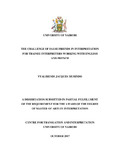| dc.description.abstract | Interpreting false friends has been a big challenge for trainee interpreters. Despite the fact that various languages, especially French, English and Spanish have provided specialized dictionaries of false friends per different pairs and other documents that make people aware of the existence of these tricky words in various language, the problem of false friends remains a challenge for trainees and false friends remain a serious trap in bilingual vocabulary. The literature has analyzed false friends, mostly as a problem of second language learning. This research was undertaken because there was a need for a systematic study on false friends in interpretation to be able to explain why they occur in renditions and how they affect the renditions of trainee interpreters The study came to the conclusion that during the renditions, false friends are the result of a transfer of the first language characteristics to the second language during the visualization and the understanding of the message. In interpretation, false friends affect the visualization and the understanding of the message conveyed in the second language whereby the interpreter takes second language words and expressions for what they are in his first language and visualize the ideas they contain according to the first language, by associating the signifiant in the second language to a signifié in the first language. From there, the accuracy of the rendition is affected, in terms of faithfulness, logic and the overall message. Also, false friends are more frequent and more challenging during consecutive interpretation than they are in simultaneous renditions. There is no a specific type of false friends that is more challenging than others. It was noted that not all false friends are responsible of contresense in renditions. Contresense occurs only when the trainee interpreter uses a false friend which the meaning is the opposite of the original meaning in the other language and within the context of the speech. | en_US |



